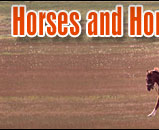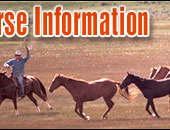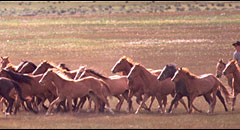 |
   |
|
|
|
You are here: Horses > Horse training > Cutting Horse Myths |
Cutting Horses: What Type of Equine Make a Good One
Many horse owners will come up with all sorts of reasons why their particular
horse would be a terrific cutting horse.
|
|
|
However, when dealing with cow horses, many
owners don’t have an accurate idea what really makes a great cutting horses. While there are always exceptions to the rules,
here are a few common myths about cutting horses. |
-
 “My colt will make a great
cutting horse, because whenever our dog (a person, another horse, etc) enters
the pasture, my colt chases it and works it just like it was a cow.” “My colt will make a great
cutting horse, because whenever our dog (a person, another horse, etc) enters
the pasture, my colt chases it and works it just like it was a cow.”
Unfortunately, this is not a reliable indicator of cutting horse potential. A
colt showing this behavior is often simply playing. The dog, person, other
horse, etc, is not a cow, and the colt has no rider whose commands it needs to
follow.
When training starts for the colt to become a cutter, it will quickly figure
out that cutting is work, not play. It must work the cow with precision, style,
and proper form, rather than running it aimlessly about the pasture. Once the
colt realizes the work involved to be a champion cutter, it might not be
inclined to do it.
A better indication of a colt’s inclination toward cutting is its breeding.
If the colt’s dam and sire are successful cutters, the colt has a good chance of
becoming a good cutter, too.
- “When I rode my colt out to gather some cattle for the first time, he
didn’t show much of a reaction to the cattle at all. He wasn’t frightened or
bothered by them. He’ll make a great cutter.”
While there are, again, exceptions to the rule, usually a colt who doesn’t
react much to its first sight of a cow does not make a good cutter. Most top
cutting horses have a strong reaction to the first cow they see—either becoming
fearful and wanting to keep the cow at a safe distance, such as the NCHA world
champion mare Doc N Missy, or behaving aggressively and attempting to dominate
the cow, like the 1990 NCHA futurity champion cutter Millie Montana.
- “My colt has terrific cutting bloodlines. She’s 99% foundation bred, and
those foundation horses were the real greats.”
Foundation bred horses can be great working cutters, but for competition
cutting, many times they are not the best. There are several reasons why this is
so.
Many foundation bred horses don’t have the intensity or “cow” to do well in
competition. Also, they can be difficult to train—either learning too slow, or
wanting to do it their own way too much. Finally, if the trainer manages to
overcome those obstacles, many foundation bred horses just don’t have the
athletic ability and style of well-bred cutting horses, and this costs them
during competitions.
If you truly want a great cutter, either buy or breed one with great cutting
bloodlines rather than foundation breeding.
- “I’m going to put my colt in training for six months with a well-known
trainer and then show him at the cutting futurity. He’ll be great.”
One of the most common misconceptions about training a cutting horse is the
amount of time it takes to produce a showable horse. To train a colt to the
level where it will be ready for a futurity takes at least eighteen months, and
depending on each individual horse, can take longer.
If your colt is extremely quick to learn, it might—might—be ready in only one
year. To have your colt competition-ready for the fall 3 year old futurities, it
needs to be started in training with cattle no later than early spring if its
second year.
Many owners are wary about beginning training that young, wanting to prevent
the colt from being injured by hard training too early. However, good trainers
will never work a young colt very hard. Instead, they concentrate on giving the
colt a solid knowledge foundation and slowly building on it to avoid stressing
the horse. If a colt is trained correctly, it will seldom get injured.
- “I’ve just bought a great cutting horse and I’m going to show him next
week. After all, cutters pretty much work on their own, so the rider doesn’t
have much to do.”
While it’s true that cutting horses often work on their own, the rider plays a
large role in how well the horse performs. An inexperienced rider will cause
even the most skilled and experienced cutter to make mistakes. Common mistakes
seen in this situation are rounding the turns, missing the stops, and losing
sync with the cow. Most new owners of cutting horses don’t realize they might
ruin their horse if they don’t learn how to correctly ride and guide it, and
quickly.
Therefore, new owners should find an experienced, knowledgeable coach to help
them learn to correctly ride their new horse. There are also good videos that
can help, but nothing is better than a good coach to make sure that the
investment in a quality cutting horse is not ruined or wasted.
|
Read the next horse training article on Head Shaking with a Martingale. |
|
|
|
|
 |
|
|
|
|
|
Horse Education
|
|
|
|
|
Horse Information Topics
|
|
|
|
|
|
|
|
Horse Business Owners
|
| |
Advertise with Us
Have your horse products or services exposed to over 27,000 of our monthly visitors.
|
|
|
|
|
|